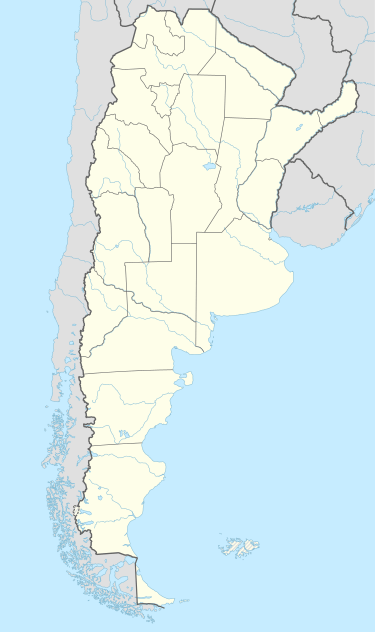Cachi, Argentina
| Cachi | |
|---|---|
| City | |
|
Catholic church | |
 Cachi Location of Cachi in Argentina | |
| Coordinates: 25°07′10″S 66°09′43″W / 25.1194°S 66.1620°WCoordinates: 25°07′10″S 66°09′43″W / 25.1194°S 66.1620°W | |
| Country |
|
| Province | Salta |
| Department | Cachi |
| Elevation | 2,531 m (8,304 ft) |
| Population | |
| • Total | 2,189 |
| Demonym(s) | n/a |
| Time zone | ART (UTC-3) |
| CPA base | A4417 |
| Dialing code | +54 03868 |
| Climate | BWk |
Cachi is a small city in Salta Province Argentina. It is the capital of the Cachi Department.
Etymology
Although it is often stated that the name is derived from Quechuan and means salt since "the snow of this hill reminds of the color of salt," it is more likely that the name is of Cacán etymology : kak (stone) - chi (silence): silent stone.
Location
Cachi is found in the northern sector of the Calchaquí Valleys in Argentina, at the foot of the Nevado de Cachi that flanks it from the west. The Cafayate, La Poma, Tolombón, Santa María, etc.) and places of interest like the Salar de Pipanaco
Climate
| Climate data for Cachi, Argentina | |||||||||||||
|---|---|---|---|---|---|---|---|---|---|---|---|---|---|
| Month | Jan | Feb | Mar | Apr | May | Jun | Jul | Aug | Sep | Oct | Nov | Dec | Year |
| Record high °C (°F) | 33.8 (92.8) |
34.0 (93.2) |
33.8 (92.8) |
32.8 (91) |
31.2 (88.2) |
28.8 (83.8) |
29.5 (85.1) |
31.0 (87.8) |
32.2 (90) |
34.1 (93.4) |
34.0 (93.2) |
34.9 (94.8) |
34.9 (94.8) |
| Average high °C (°F) | 26.2 (79.2) |
25.7 (78.3) |
25.7 (78.3) |
24.1 (75.4) |
22.6 (72.7) |
21.2 (70.2) |
20.8 (69.4) |
22.1 (71.8) |
23.3 (73.9) |
25.9 (78.6) |
27.0 (80.6) |
27.1 (80.8) |
24.4 (75.9) |
| Daily mean °C (°F) | 18.4 (65.1) |
17.8 (64) |
17.0 (62.6) |
14.2 (57.6) |
11.3 (52.3) |
9.6 (49.3) |
9.6 (49.3) |
11.4 (52.5) |
12.5 (54.5) |
15.9 (60.6) |
17.6 (63.7) |
18.6 (65.5) |
14.5 (58.1) |
| Average low °C (°F) | 11.8 (53.2) |
11.0 (51.8) |
9.7 (49.5) |
5.0 (41) |
0.8 (33.4) |
−0.7 (30.7) |
−0.8 (30.6) |
0.8 (33.4) |
2.2 (36) |
5.7 (42.3) |
8.7 (47.7) |
10.8 (51.4) |
5.4 (41.7) |
| Record low °C (°F) | 5.0 (41) |
4.4 (39.9) |
0.2 (32.4) |
−4.0 (24.8) |
−7.1 (19.2) |
−10.1 (13.8) |
−10.6 (12.9) |
−10.5 (13.1) |
−8.6 (16.5) |
−5.2 (22.6) |
−0.7 (30.7) |
1.8 (35.2) |
−10.6 (12.9) |
| Average precipitation mm (inches) | 67.1 (2.642) |
34.5 (1.358) |
14.5 (0.571) |
2.3 (0.091) |
0.0 (0) |
1.3 (0.051) |
0.1 (0.004) |
0.5 (0.02) |
0.4 (0.016) |
2.9 (0.114) |
3.3 (0.13) |
28.4 (1.118) |
155.2 (6.11) |
| Average relative humidity (%) | 62 | 62 | 61 | 55 | 44 | 36 | 35 | 39 | 41 | 46 | 50 | 55 | 49 |
| Source: Instituto Nacional de Tecnología Agropecuaria[1] | |||||||||||||
Population
The dynamic demographics are important: in 2001, 5254 people were counted, a 17.62% increase over the last census in 1991. Two factors have contributed to the increase: the high birth rate and the movement of people from Salta, Tucumán and Buenos Aires to the region.
Tourism

The population is found surrounded by imposing snow-covered mountains reaching as much as 5,000 meters. The temperature is usually mild and the skies are almost always clear, making the region ideal for mountain climbing. The architecture of the small city is principally of colonial Spanish style with adobe homes painted white and built over bases of rock, sporting antique window grills forged of iron. In the Central Plaza is the Church of Chachi, a recognized National Historical Monument, built in the sixteenth century with an exterior from the nineteenth century. Its beams, altars and confession booths are all carved from the porous wood of the cactus Echinopsis atacamensis. The front of the plaza is the main entrance to the Pío Pablo Díaz Archaeological Museum. This museum contains more than 5,000 pieces covering a time period of 10,000 years with a majority covering the time period between 800 BC and 1600 AD. Ancient pictographs figure prominently in the museum, and the staff is extremely knowledgeable about them---and comparative pictrographs around the world. 10 kilometers to the south-southwest of Cachi lies the important ruins of Puerta de La Paya.
Cachi also has the world's highest vineyard, Bodegas Colomé.[2]
External links
| Wikimedia Commons has media related to Cachi. |
References
- ↑ "Estadisticas Climatologicas de La Provincia de Salta" (PDF) (in Spanish). Instituto Nacional de Tecnología Agropecuaria. pp. 21–33. Retrieved March 12, 2015.
- ↑
